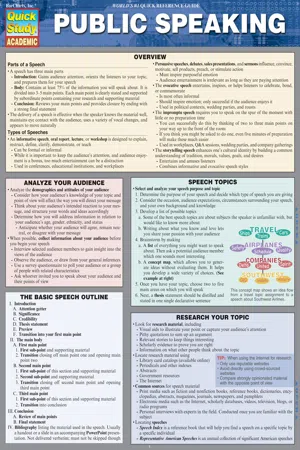
This is a test
- 4 pages
- English
- ePUB (mobile friendly)
- Available on iOS & Android
eBook - ePub
Book details
Book preview
Table of contents
Citations
About This Book
From the organization of a speech to knowing your audience, your vocals, and the delivery, this essential guide covers an entire course on public speaking yet is handy enough to reference throughout your speech preparation. With more preparation comes more confidence and with added inspiration throughout this guide you will stand to deliver.
Frequently asked questions
At the moment all of our mobile-responsive ePub books are available to download via the app. Most of our PDFs are also available to download and we're working on making the final remaining ones downloadable now. Learn more here.
Both plans give you full access to the library and all of Perlego’s features. The only differences are the price and subscription period: With the annual plan you’ll save around 30% compared to 12 months on the monthly plan.
We are an online textbook subscription service, where you can get access to an entire online library for less than the price of a single book per month. With over 1 million books across 1000+ topics, we’ve got you covered! Learn more here.
Look out for the read-aloud symbol on your next book to see if you can listen to it. The read-aloud tool reads text aloud for you, highlighting the text as it is being read. You can pause it, speed it up and slow it down. Learn more here.
Yes, you can access Public Speaking by in PDF and/or ePUB format, as well as other popular books in Languages & Linguistics & Linguistics. We have over one million books available in our catalogue for you to explore.
Information

Delivery
Modes of Delivery Choose the mode of delivery that enhances your speech
- Extemporaneous: The speaker uses a brief outline and key terms and quotes. He or she demonstrates knowledge and understanding of the content. This method allows the speaker to maintain eye contact, adapt to the audience, and speak in a dynamic conversational style
- Impromptu: The speaker has limited time to prepare, usually less than five minutes. He or she can generate three main points and a first and last line by taking a moment to gather thoughts. This method can often appear spontaneous and dynamic
- Memorized: The speaker memorizes the speech word for word. This method is not recommended for beginning speakers because it is very difficult to build audience dynamics when you are thinking about the words rather than the meanings they convey
- Manuscript: The speaker reads the speech word for word from a manuscript, cue cards, or a teleprompter. This method is used when precise accuracy is required. It is not as dynamic as the extemporaneous mode because the speaker’s eyes are on the paper, not the audience. As with the memorized method of delivery, the manuscript method makes it much harder to stay in touch with audience dynamics
- Volume
- Created by using your diaphragm to push air forcefully through your larynx and out your mouth. The more air you expel, the louder you can project your voice
- To increase your overall volume: Relax, take a deep breath, release the tension in your throat and say “ahhhhhh...” Remember the key to proper volume is supported breathing
- Most people are able to maintain a louder volume by lowering their pitch
- In order to avoid speaking in monotone, you will want to make sure there is good contrast when your voice is loud and when it is soft. To do this, use your diaphragm to project, while using inflection to emphasize
- Keep your volume constant as you speak. Avoid letting your voice fade into nothingness. However, raise your volume for certain exciting or dramatic parts and it will catch your audience’s attention
- Too quiet a volume and your audience will have to strain to hear you; too loud and you will come across too aggressively
- Remember to be clearly audible all the way to the back of your space. Whenever possible, test this before you begin your speech
- Rate
- The speed at which we talk
- When you are nervous, you are likely to speak more quickly. Watch as you practice that you don’t speak too quickly because you will probably speak a little bit faster on stage than you do in practice
- Remember that people don’t all hear equally well. Slow down to be more audible to those with hearing difficulties
- Optimal range is 150 to 185 words per minute
- Speak too fast and your audience will lose details; too slow and they’ll be bored
- A faster rate suggests excitement or nervousness; a slower rate encourages your audience to focus on the details
- Vary your rate. Slow down to highlight the important parts of your speech and speed up to raise tension
- Pitch
- How high or low your voice is
- The faster the vocal folds vibrate, the higher the pitch; the slower they vibrate, the lower the pitch
- Adjusting your pitch according to what you are saying will sound more natural and more interesting. A unvarying pitch is monotonous and will lose your audience’s attention
- Many people use a higher pitch when they are giving speeches, although an overly high pitch is less vocally appealing, and does not suggest authority. On the other hand, too low a pitch and you will tend to mumble slowly as you speak
- Rhythm
- The combination of a speaker’s pace and the breaks which punctuate new ideas
- Pause before a big idea or when you particularly want to draw your audience’s attention. This creates suspense
- Knowing what you want to say, and having practiced until you are confident, will help you speak with an appealing and natural speaking rhythm
- Pauses
- Vary in length and frequency
- Use them to create tension
- A skillful speaker will control and place them to create impact
- Word Emphasis

- The emphasizing of key words by changes in the volume, rate, pitch, or pause patterns to highlight key ideas
- Decide which words are key by asking yourself what you most want the audience to hear, what is most likely to be news to them, and what the ultimate goal of your speech is
- Try saying the sentence “Please fetch me that book.” Each time you say it, emphasize a different word. You will find that it entirely changes the meaning
- Articulation
- Mostly, good articulation depends on speaking very carefully. Each word must be actively said
- Best improved by practicing precise speaking
- Open your mouth all the way, keep your lips active, and move your muscles more
- Vocal Quality
- The sound of your voice. An unpleasant voice is a serious distraction to an audience
- Keep an open throat to avoid having an overly nasal voice
- Relaxing and generally lowering muscle tension will improve vocal quality
- Emotion
- Use more open emotion in persuasive speeches and less in formal speeches
- Practice putting realistic-sounding emotion into your speeches by thinking about when you would intensely f...
Table of contents
- Overview
- Analyze Your Audience
- The Basic Speech Outline
- Speech Topics
- Research Your Topic
- Speech Organization
- Language
- Delivery
- Presentation Aids
- Setting
- Using Notes
- Practice
- Persuasive Strategies
- Overcoming Fear
- Be Guided by Your Audience
- General Tips
- Increasing Interest & Understanding